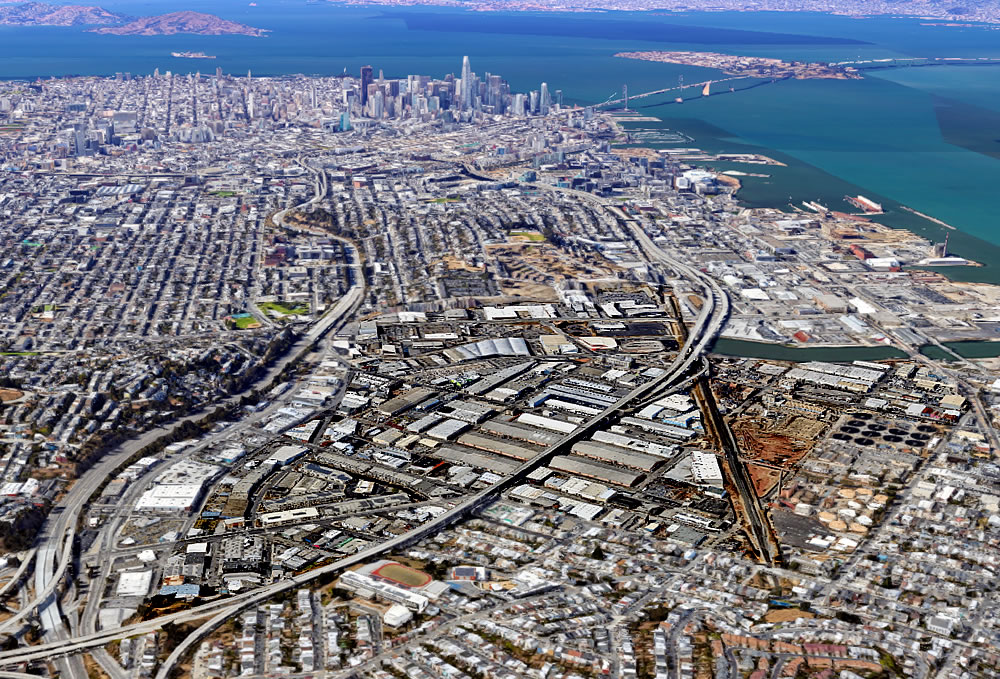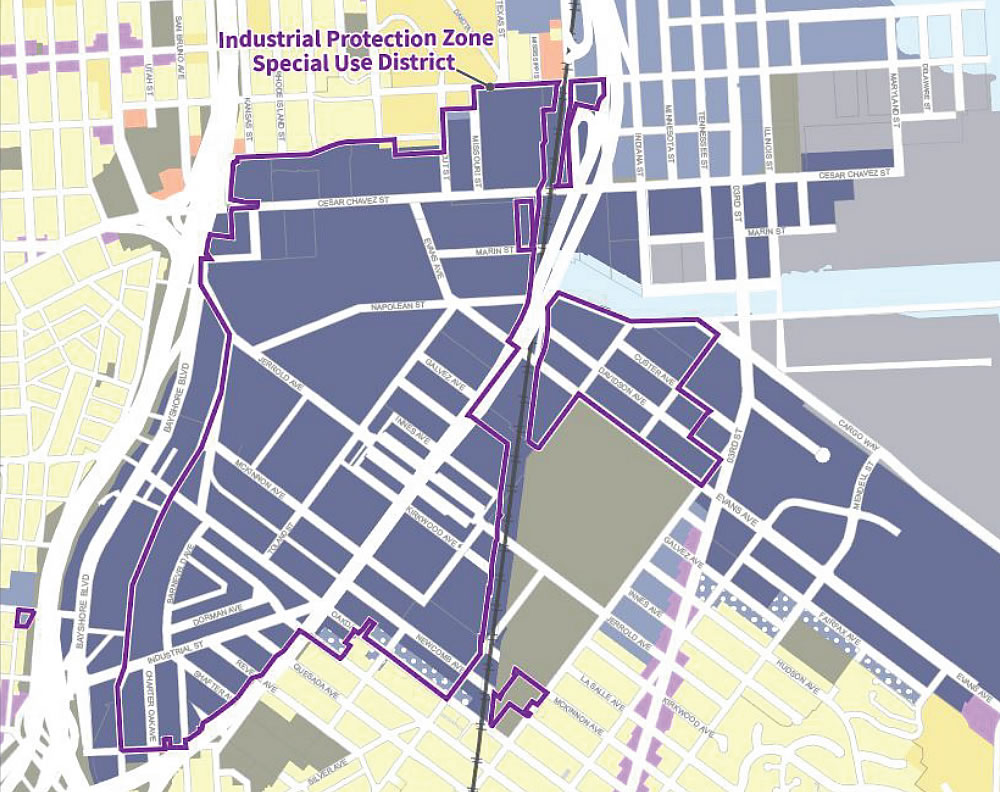Created in 2001 to protect industrial businesses from being displaced by higher-paying residential, retail and office developments in San Francisco’s Eastern Neighborhoods, the City’s Industrial Protection Zone (IPZ) Special Use District applies Manufacturing (M) zoning controls to a large swath of land in Bayshore and western Bayview, generally bounded by 25th /26th Streets to the north, the Caltrain right-of-way to the east, Oakdale/I-280 to the South, and Barneveld/Loomis to the west (along with an area east of the Caltrain right-of-way, between Islais Creek to the north and the PUC Southeast Treatment Plant to the South, and a couple of other little patches as outlined below).
Plans to eliminate the Industrial Protection Zone Special Use District could be approved by San Francisco’s Planning Commission next week, however, at which point the underlying production, distribution and repair (PDR) zoning would then apply to the areas if then adopted by San Francisco’s Board of Supervisors.
From San Francisco’s Planning Department:
For decades, the M districts have allowed for a wide array of industrial and maritime uses in the eastern half of San Francisco, including those involving heavy truck traffic, noise generation or noxious emissions. When these zoning classifications were created, there was little demand from non-industrial uses in the industrial areas. Consequently, the operational and economic conflict between industrial uses and non-industrial uses was low.
Since the 1990s, however, the permissiveness of the M zones has been found obsolete and ineffective in dealing with the City’s market forces and land use dynamics. As the City’s economy changed over the last three decades, sensitive and more economically attractive uses like housing and office located within or adjacent to the M Districts. This raised concerns about compatibility and quality of life for residents in areas not designed for residential life; concerns about the ability to conduct industrial activity in such environments; and concerns about the preservation of industrially used land necessary for the City’s economic functions and diversity.
As a result of these dynamics, over the past 20 years the City rezoned almost all M-zoned parcels not under the jurisdiction of the Port, through the Eastern Neighborhoods, Bayview, and other comprehensive planning efforts. Several M district parcels in the Bayview and along infrastructure corridors were rezoned in September 2020.
It was an oversight not to remove the IPZ when PDR zoning was adopted in 2008. By referring to obsolete M-1 and M-2 zoning, the IPZ undermines the more robust, underlying PDR controls [and] leaves a loophole that allows self-storage, big box retail, and heavy industrial uses that are inappropriate for active and thriving PDR neighborhoods.
As plugged-in people should know, while residential and general office uses are not allowed within PDR districts, lab space, including ancillary office space to serve said labs, is a permitted PDR use.
In addition the proposed ordinance that would eliminate the IPZ would also newly allow Social Service or Philanthropic Facilities uses of greater than 5,000 gross square feet on parcels zoned Production, Distribution and Repair 2 (PDR-2) throughout the city. We’ll keep you posted and plugged-in.


So, this was the “grander plan” referred to in the massive distribution facility story a few days back. Nice setup!
It looks like our corrupt politicians and unfaithful public servants (and their friends in real estate) want to to sacrifice our traditional industrial zone on the altar of greed.
Real estate near the heart of one of the densest and most expensive cities in the world shouldn’t be artificially preserved as industrial. I’ve always thought it nothing short of bizarre, if not irrational and depressing, that just a couple miles south of downtown or east of Portrero Hill there are literally junkyards and scrap heaps.
Yeah – not only that but the fact that we’ve decreed that industrial pollution shall remain in/near sensitive communities when it got put there in the first place because of lack of political power / our disregard for their wellbeing is stunning.
It’s artificially preserved because of the government created zoning law. If it wasn’t for that I’m sure it would have been rehab a long time ago
These are blue collar jobs for the last of the locals in the working class neighborhoods. Clean it up, sure, but this city needs to ensure it produces physical goods and that there are all types of jobs to support her citizens of every expertise.
It’s too bad the city didn’t mandate that the shipyards stay open to preserve shipyard jobs.
How would the city have “mandated” that shipyards remain open and active? It’s not up to them at all. If a maritime-related business or the federal government doesn’t want to operate at the shipyards, the city can’t force them to.
I believe ‘SFRealist’ is being facetious…a burlesque of the tendency of politicians to (attempt to) solve problems by fiat.
Thank you Notcom. Maybe I was being too subtle.
I would LOVE to see all of the parcels along the northside of Cesar Chavez (if not both sides) get rebuilt to help connect The Mission to Dogpatch and Bayview, and ultimately the rest of the city.
Residential, mixed-use would be ideal but even if all of those single-story warehouses and parking lots along the bottom of Potrero were built up, it’d make a huge difference.
I’m all for adding housing and retail to this area, but building up Caesar Chavez east of potrero ave would do little to connect mission and dogpatch, since there would still be a disgusting highway interchange and a 50 foot cliff in between them.
Ditto.
Those single story warehouses at the foot of Potrero Hill are home to cool stuff like M5 Industries special effects studio/warehouse, which was the home base of the most amazing Mythbusters crew. Without warehouses and industrial areas, we’ll become nothing but a residential burb and nothing artistic, innovative and interesting created that doesn’t come from a computer program. (and lots of other practical functional reasons why a city needs some industrial space.)
A bit hyperbolic… Nothing happens all at once and I doubt adding some density and improving the connection between the Mission and Dogpatch would turn this into the burbs.
Either way, I agree that we need some industrial space in and around the city and that it’s crucial and often where the creative space is. Just not sure we should sacrifice important connections for a few warehouses and half vacant parking lots.
I mean, I don’t think it’s going to become an enclave, but it’s better than hiking up over the hill via 23rd or heading north towards 16th or 17th. All that housing that being built on the backside of Portrero is basically bound on 3 sides by highway and that 50ft cliff you mention. Maybe some trees and a full repaving would help make it feel safer and cleaner?
I used to have a reahearsal studio on Cesar Chavez near Evans, literally in one of those single story warehouses along the bottom of Portrero. If you spent any time out there (which clearly you haven’t) you would NEVER want more residential along this corridor. This is a massive artery for freight operations around San Francisco. The pollution alone would be a nightmare, but add in the danger to pedestrians, the noise and the pounding the road takes and you have a recipe for disaster.
I commute that way almost daily. And yes, it’s a dirty, loud, unsafe, not-so-fun route—whether in a car or on a bike—which is why I’m suggesting it could benefit from some reworking and deindustrialization.
The logic that it’s currently sh*tty and therefore it shouldn’t be improved, would’ve left the entire shoreline of the city as a hazardous wasteland.
The demand for use in this area will be for bio-tech/lab use. New production space – not so much. New distribution space? Not so much either with two massive distribution centers planned for the area. This is a perfect way to parley off of the Mission Bay nexus and build a massive health centered/bio-tech hub. Provide space for the huge overflow demand for bio-tech coming from SSF and the Peninsula. Housing? At strategic spots and obviously not near the freeway. The neighborhood will naturally remain low rise with bio-tech uses.
The Exchange has managed to sublease some of the space vacated by Drop Box to bio-tech companies. The demand is there. So much so that the developer of 88 Bluxome in SOMA wanted to convert the project to life science space but that entailed elimination of the tennis courts which Planning has effectively quashed.
It is not enough to simply rezone. There needs to be a vision. A build out from/an addition to Mission Bay with good paying jobs and housing. It’s a no-brainer but this is San Francisco and will the City PTB seize on that vision?
100% agree.
It is short sighted for SF not to realize that micro manufacturing will be making a comeback and the city would lose its vitality and attraction if it becomes just residential and officesz
Need data regarding existing jobs within the zone before a reasonable decision can be made. How many middle class wage earners are there?
It would be foolish to eliminate all of our remaining PDR districts. If you want to eliminate or significantly reduce PDR in SOMA and Showplace Square, that kind of makes sense, but I think it would also make sense to keep some….especially within the Islais Creek industrial area between 101 and 280. I guarantee it’s all occupied down there. It’s a forklift frenzy. Not sure it would make good residential land what with the cruddy landfill, industrial pollutants in the soil, etc.
I generally agree with this. I think we can apply the same logic to PDR as we do housing and focus on making the area denser and accomodating a richer array of commercial activity and transportation options. Not everything needs to become housing, but not all PDR needs to be 80-year-old, single-story warehouses that line trash-covered, pitted streets.
I live right on the NW side of that zone and frequently walk the neighborhood. The entire area reeks of neglect, abandonment and there is trash everywhere. RVs are parked everywhere. Many businesses are permanently closed (including the famous Clam House) We get local brush fires every couple weeks, especially around the Cesar Chavez underpass. Many times started by the homeless who are forever stuck there. If you have ever taken the overpass on Faith and Bayshore you know that this area needs a complete overhaul.
The OC clams …er claims it’s reopening, eventually. Do you have specific info to think otherwise ??